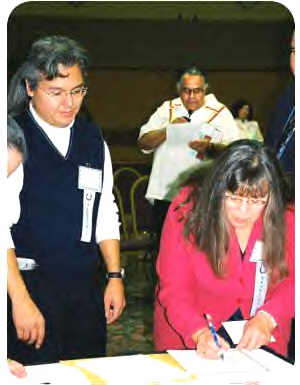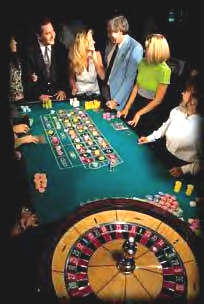Despite Big Gambling Bucks, Indians 50 Years Behind, Harvard Study Shows
|
||||||||||
| Printer Friendly Story View |

Saginaw Chippewa Chief Audrey Falcon, right, and Aaron Payment of the Sault Ste. Marie Chippewa and Frank Ettawageshik, center, of Little Traverse Band of Odawa, sign Tribal and First Nation Great Lakes Water Accord last fall.
(EDITOR'S NOTE: This is the first of a three part series on Native Americans, including the Saginaw Chippewa in Mt. Pleasant, Michigan. The first eyes the impact of gambling on the economic status of tribal members over the past decade. The last two articles will focus on testimony of the Saginaw Chippewa and five other tribes before the U.S. Senate Committee on Indian Affairs charging that lobbyists aided by tribal insiders received more than $66 million, mostly fraudulently.)
Despite a bonanza in gambling revenues over the past decade, it will take Native Americans at least 50 years to catch up economically with the rest of the country.
That's a main conclusion of a recently released Harvard University study of the socioeconomic impacts of American Indian Government gaming.
Recent national news reports trumpeted reports from the National Indian Gaming Association that Indian gambling grossed $18.5 million in 2004, nearly double the income of Las Vegas.
However, the news reports gave few details about the socioeconomic status of Native Americans. The association said gambling has created 553,000 jobs, mostly for non-Indians, and generated $5.5 billion in federal taxes last year.

There are 411 Indian casinos operated in 28 states by 223 tribes. The $18.5 million in gross gambling revenue was about a quarter of all gambling revenues in the country. Payroll and other costs consume about a third of the revenue.
Reports from the Saginaw Chippewa tribe indicate that an estimated $3.35 billion in gambling revenues have been garnered at the Soaring Eagle Casino since 1994. The tribe recently allocated $4 million to local governments and school districts as part of the "two percent process." In accordance with its agreement with the state, the tribe distributes two percent of its Class III gaming revenues on a semi-annual basis.
The amount of the recent distribution would indicate that the tribe took in approximately $400 million just in gambling revenues in the past year. Soaring Eagle is considered one of the top Indiangaming centers in the nation.
Meanwhile, hearings before the U.S. Senate Indian Affairs Committee have received testimony from the Saginaw Chippewa and five other tribes in gaming regarding tampering with tribal elections and fraud by lobbying firms. That action will be updated by this writer in two subsequent articles.
Another major conclusion of the Harvard Project on American Indian Economic Development is that the recent emphasis on native self government has economically benefited all tribes, those which operate gaming enterprises and non-gaming tribes as well.
"Having started the 1990s with incomes lagging far behind those for the general U.S. population, American Indians in Indian Country experienced substantial growth in income per capita," study co-authors Jonathon B. Taylor and Joseph P. Kalt state.
Real per capita income is up 36 percent for tribes in gaming and 21 percent for non-gaming tribes. Per capita income in the U.S. as a whole increased 11 percent over the same 1990-2000 period. (The Navajo tribe is excluded from native figures because that tribe's extraordinary gaming success would skew the results.)
The reason for improvement in non-gaming tribes is stated bythe study report: "Self-rule brings decision making home, and local decision makers are held more accountable to local needs, conditions and cultures than outsiders. Prior to the present era of Indian self-determination, decades of distant decision making by federal and state authorities accountable to non-Indian constituencies and masters had shown little discernable ability to break repeated patters of poverty and social disarray."
Despite this improvement, real per capita income of natives in Indian Country was less than half the U.S. level, family poverty three times the U.S. rate, unemployment more than twice the national rate and the proportion of adult college graduates half the proportion for the U.S. as a whole, according to the Harvard study.
The Saginaw Chippewa tribe of 3,017 membvers reportedly has no unemployment. A portion of gambling profits goes for $78,000 per year payments to each adult member and $12,000 per year for each child member of the tribe.
The study concludes: "Much remains to be done to close the gap: If U.S. and on-reservation Indian per capita incomes were to continue to grow at their 1990s' rates, it would take half a century for tribes to catch up."
The authors urge continuation of the policy of Indian self-determination, implicit in sovereignty status of tribes. "Without self-determination, "gains in Indian Country could easily be reversed," the authors warn. "Such a reversal would dash prospects for socioeconomic progress and increase demands that federal and state governments address the problems of reservation poverty. That would be a losing proposition for all."
(NEXT WEEK: Saginaw Chippewa testify in U.S. Senate hearings that lobbyists fleeced tribe of $14 million with help of eight insiders, since purged from the tribal council.)###
| Printer Friendly Story View |
|
|

Dave Rogers |
|
|
|
Printer-Friendly Story View
0200 Nd: 04-20-2024 d 4 cpr 0
12/31/2020 P3v3-0200-Ad.cfm
SPONSORED LINKS
12/31/2020 drop ads P3v3-0200-Ad.cfm


